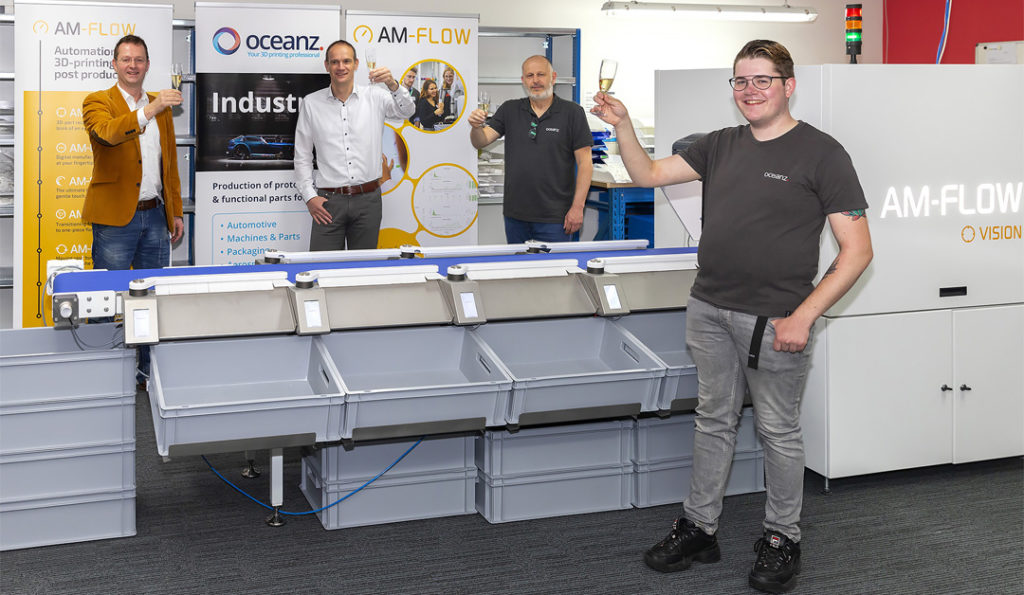3D printing service Oceanz has implemented two AM-Flow modules, AM-VISION and AM-SORT, to automate aspects of their manufacturing workflow. AM-VISION is an automated part identification module that uses machine vision to recognize parts and match them with orders and further production steps. The AM-SORT module is a module that uses flippers to sort parts and move them to different production steps.

The companies tout the ability to track parts throughout the entire production process from file to print to finished part as one of the advantages. This allows Oceanz to have more efficiency and lower costs while increasingly their level of control over part handling. A lot of manual labor is eliminated and repeatability is increased by removing the human element. At the same time, automated operations could help them to meet or exceed part traceability requirements for heavily regulated parts. The companies would like to go further and automate more warehouse operations as well as quality assurance.
“Common sense and hands-on approach has allowed us to take steps so quickly. We look forward to a long further collaboration to make Oceanz even stronger,” said AM Flow CEO Stefan Rink.
“This collaboration confirms our own down to earth and practical mentality, and the pleasant collaboration with AM Flow as a 3D workflow automation specialist, working towards a shared vision of the market. This application is necessary to take the next step and fits perfectly with the future demands and, therefore, with Oceanz,” Oceanz CEO Erik van der Garde added.

In 3D printing, manual labor in part cleaning and conveyancing can add up to become around 30% of the total part cost. This is an astronomical proportion. Whereas people often think of 3D printing as a fully automated process, a lot of components have to be manually cleaned, sorted, de-powdered and carried around. The sum total of this activity makes 3D printing much less economical than it should be. Moves such as those from Oceanz and AM-Flow should be lauded because, ultimately, they will make printing less expensive for all of us.

Post-processing companies such as Dye Mansion and PostProcess Technologies are trying to automate steps such as depowdering and surfacing of parts in one unit or in series of machines. Meanwhile, most post-processing is batch-based, so there is still conveyancing of builds in between machines. At the same time, with many orders coming into a service bureau, the identification of individual items is very important in 3D printing. An SLS build could have hundreds or tens of thousands of parts in it. To identify them all is tedious and costly. Through AM-Flow such procedures can be automated, which will really have an impact on costs.
At the same time, I believe that all quality assurance will have to be automated in 3D printing. Since we build up each item individually and tool paths, part placement, heat, and bonding is often very different we need to check each and every individual component, in my opinion, to be sure that it has been built correctly. So, automated QA processes, such as scanning for surface roughness and dimensional accuracy, are sorely needed.
The bigger and the faster the post-processing portion of the 3D printing industry grows, the better their offering will be. The more comprehensive, the faster, and the more efficient all of these players are, the more we can reduce costs.
I really believe that we need to catch up with expectations here. We are not making coffee beans or artesian candles. We should be able to make components that are not touched by humans. Sadly, at this point each part is probably handled at least four times by a person before it reaches the customer. We have a lot of individuals going around claiming to perform manufacturing, but we need Kinder Egg prices and Faberge quality people. We now have Faberge egg prices and Kinder egg strength instead.
Developments such as these will reduce costs, freeing up margin to tackle new business cases or to invest in further automation. Post-processing equipment and workflow is key to unlocking our collective manufacturing future. So far, SmarTech Analysis has been the only company in 3D printing market research to publish a report dedicated to this topic. Its “Automation, Additive Manufacturing and the Factory of the Future” report details the state of the market as it relates to automation and what it will take to get to a fully-automated Industry 4.0.
Subscribe to Our Email Newsletter
Stay up-to-date on all the latest news from the 3D printing industry and receive information and offers from third party vendors.
You May Also Like
Precision at the Microscale: UK Researchers Advance Medical Devices with BMF’s 3D Printing Tech
University of Nottingham researchers are using Boston Micro Fabrication‘s (BMF) 3D printing technology to develop medical devices that improve compatibility with human tissue. Funded by a UK grant, this project...
3D Printing Webinar and Event Roundup: April 21, 2024
It’s another busy week of webinars and events, starting with Hannover Messe in Germany and continuing with Metalcasting Congress, Chinaplas, TechBlick’s Innovation Festival, and more. Stratasys continues its advanced training...
3D Printing Webinar and Event Roundup: March 17, 2024
It’s another busy week of webinars and events, including SALMED 2024 and AM Forum in Berlin. Stratasys continues its in-person training and is offering two webinars, ASTM is holding a...
3D Printed Micro Antenna is 15% Smaller and 6X Lighter
Horizon Microtechnologies has achieved success in creating a high-frequency D-Band horn antenna through micro 3D printing. However, this achievement did not rely solely on 3D printing; it involved a combination...





























